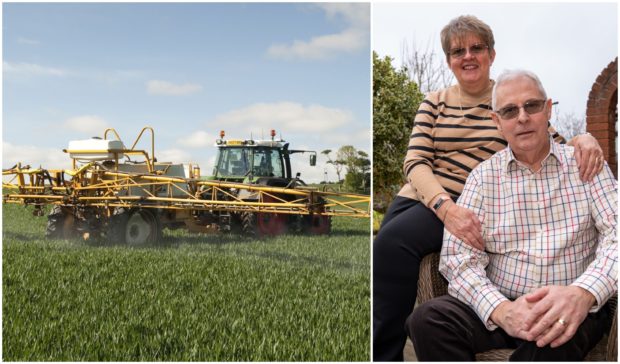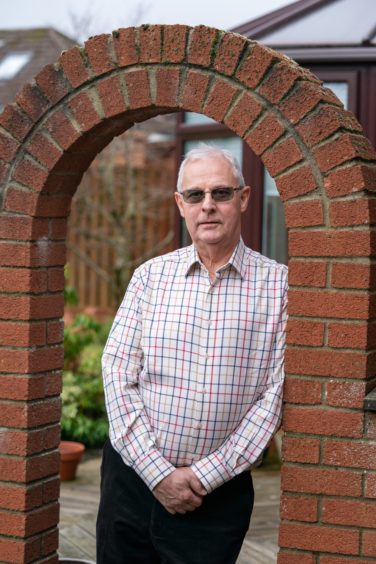
Chemicals used in farming may be a factor as male breast cancer cases double in Scotland, according to research.
The first Scotland-wide survey reveals that, over 25 years, the incidence of the disease in men has jumped from 0.8 to 1.3 per 100,000 men per year. And the largest rises in cases has been in the Western Isles, Borders, and Dumfries and Galloway.
The disease, largely confined to the over-50s, often proves fatal because men are not alert to the symptoms and do not seek diagnosis or treatment quickly enough.
Breast cancer cases in men are rare, but still about 400 men are diagnosed with the disease each year in the UK, with Scotland contributing approximately 25 cases.
Lead author Valerie Speirs, professor of molecular oncology at Aberdeen University, said: “There has been pretty much a doubling of the incidence over the 25-year period.
“We looked the whole of Scotland and across various health boards. What we found was it looked as if in rural areas it was perhaps slightly higher than in urban areas.
“Dumfries and Galloway and the Borders are areas associated with farming and perhaps the pesticides might be an issue.
“Some of the pesticides used in agricultural industry may well mimic the effects of some of the hormones that are associated with increased breast cancer risk, and that may be part of the reason we are seeing higher numbers.
“Endocrine-disrupting agents may impact not just on cancer, but other aspects of health too.”
Endocrine-disrupting chemicals may affect hormones and can cause cancer. Released into the environment from different sources, they are mainly used in packaging industries, pesticides and food constituents.
More than 50 pesticide active ingredients have been identified as endocrine disruptors by the European Union.
They enter the body, disrupt hormones and cause adverse developmental, disease and reproductive problems.
Professor Speirs said: “Endocrine-disrupting chemicals are found in things like plastic water bottles and the lining of food containers. It is difficult to avoid them, but there is a big push by some of the regulators to try to get these substances removed, so there isn’t any level of exposure to these.”
Part of the overall rise in male breast cancer cases was down to people living longer, and under-reporting in the past, she suggested.
“Cancer is associated with ageing, and perhaps men are a bit more aware now that something is wrong and that they need to go to their GP.
“Maybe 25 years ago they would have just ignored it. Then either they died with the disease, without even knowing they had it or before it became a bigger problem.”
However, according to Professor Speirs, it is not just rise in cases that raises questions.
Many treatments for male breast cancer are the same as those used in women –surgery, radiotherapy and chemotherapy.
Very few studies have targeted drug treatments specifically for male breast cancer and, as a result, most treatments used are those known to work for women.
Professor Speirs said, however, there were differences at a molecular level between male and female breast cancer.
“All existing treatments men with breast cancer receive are those we know work very well in women. But it may be there could be a call to design bespoke treatment for men with breast cancer so we can target molecules expressed by male breast cancer.”
Male breast cancer accounts for 1% of all breast cancers diagnosed, with 93.7% of patients being over the age of 49.
From 1992 to 2017 there were 558 diagnoses in Scotland.
Across the whole of Scotland incidence rose by 38.5% – 54% in the north, 21.4% in the south-east and 46.2% in the west.
But health boards in three of the most rural regions – the Borders, Dumfries and Galloway and the Western Isles – showed the greatest rises per head of population, “indicating that male breast cancer is most prevalent in these regions”.
As well as “gender-bending” chemicals, obesity and increasingly sedentary lifestyles have been blamed for a rise in the disease.
Dr Kotryna Temcinaite, research communications manager at the charity Breast Cancer Now said: “These important figures illustrate just how much there is still to do to tackle breast cancer in men. With this study showing incidence has risen in Scotland over the past 25 years, research will be crucial to gaining a better understanding of its causes, how it differs to the disease in women and how best to treat it.
“While it’s an interesting pattern that more breast cancers have been diagnosed in men in rural areas of Scotland, more research is needed before we can speculate about any potential causes, particularly given the small numbers of cases involved.
“There is no conclusive evidence that exposure to chemicals in the environment such as pesticides and plastics increases the risk of breast cancer, both in men and women. Our Male Breast Cancer Study is now trying to pinpoint the genetic, environmental and lifestyle causes of breast cancer in men, which could enable us to identify those who are at greater risk and what could be done to help lower the chances of developing the disease.
“It’s important all men know to get any unusual changes to their breasts checked out by their GP as soon as possible. Anyone with questions or concerns about breast cancer can call our free helpline on 0808 800 6000 to speak to one of our expert nurses.”
Natasha Paton, health information manager at Cancer Research UK, said that, while cases of male breast cancer were rare, small changes could help cut the risk.
She said: “The latest data for Scotland show that in 2017 there were 30 new cases in men, compared with 4,700 in females.
“As with most cancer types, the biggest risk factor for breast cancer in men is getting older. But there are things we can do to reduce our risk of cancer overall, such as stopping smoking, keeping a healthy weight and cutting down on alcohol.”
NFU Scotland Policy Manager Jenny Brunton said chemicals used in farming were regulated by a European agency.
She said: “NFU Scotland believes science must come first and foremost in deciding the safety and effectiveness of plant protection products (PPPs). The European Food Safety Authority (EFSA) conduct rigorous science-based regulatory assessments when regulating endocrine disruptors. NFUS will continue to highlight the need to consider risk of exposure to substances and potency of the chemical when regulating. This view was also expressed by EFSA when it carried out its own assessment.
“Scottish farmers recognise the importance of professional and responsible use of products with pesticide use in Scotland further decreasing in 2018.
“While often the popular focus of attention is on pesticides and biocides, it is equally important for the regulatory framework to address endocrine disruptors across all other relevant regulatory areas, such as toys, cosmetics, food contact materials, medical devices and chemicals in general. In addition, the framework should consider natural sources of endocrine disruptor exposure.”
‘I was extremely surprised when I was diagnosed. I wasn’t aware that men could get breast cancer’
It was Iain Glen’s wife, May, who first spotted the signs of male breast cancer.
A health and safety worker in the construction industry, from East Whitburn in West Lothian, Iain had just turned 50.
“There were little spots of blood appearing on the bed sheets during the night. They were where I would have been lying on my chest.
“My wife noticed it. It was almost if I had knocked the head off a spot. We realised it was a slight discharge from the left nipple, so she got me to the hospital.
“The doctor was a bit unsure about it, and I was referred to St John’s Hospital, Livingston, where they took a small biopsy. It wasn’t totally clear so they asked for another one.
“After that I was told, ‘You have breast cancer, but it’s in the early stages. On a scale of one to three, it is a one.’
“So it was a relatively low-risk, but it was still cancer. “Basically, they did a mastectomy.
“With a man, it is not really noticeable and I didn’t need any radiotherapy or chemotherapy.
“I was put on a drug called Tamoxifen. I was supposed to be on it for five years, but it left me utterly exhausted so I stopped it after two.
“Every year, about the anniversary of the operation, they checked the site for any recurrence. Nothing happened – nothing showed up and about five years ago they stopped.
“The only side-effect was lymphedema in my left arm for a couple of years – because they removed a lot of lymph nodes from the armpit – but they were all clear, which was a good indication that the cancer hadn’t spread.
“That would appear to be correct as I haven’t had any further problems.
“To all intents and purposes I lead a normal life and, as far as the breast cancer is concerned, surgery seems to have got rid of it.”
Mr Glen, now 68, whose family had no history of cancer and was a non-smoker, added: “I was extremely surprised when diagnosed, because I wasn’t aware that men could get breast cancer.
“My wife was, she had just seen an article on it.”
Mr Glen, who is now retired, added: “Ironically, my wife was diagnosed with breast cancer in 2013, just before Christmas, but she has remained free from it.
“She had keyhole surgery and a course of radiotherapy.
“But perhaps because we have both been through it, they made some checks on my daughter, but didn’t find anything.”
Mr Glen said: “When I’m wearing clothes you wouldn’t know I have had a mastectomy, it is only if I am swimming that you would realise there is a scar across the left side of my chest.
“I maybe felt a wee bit self-conscious the first time I went swimming, but nobody looked at me, or pointed at me.
“I don’t even think about it now. I was very fortunate.”

Enjoy the convenience of having The Sunday Post delivered as a digital ePaper straight to your smartphone, tablet or computer.
Subscribe for only £5.49 a month and enjoy all the benefits of the printed paper as a digital replica.
Subscribe © Kenny Smith Photography
© Kenny Smith Photography